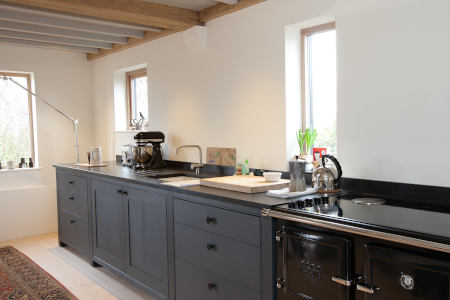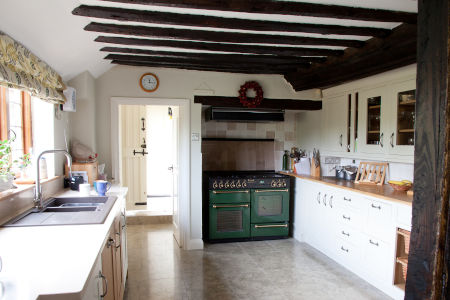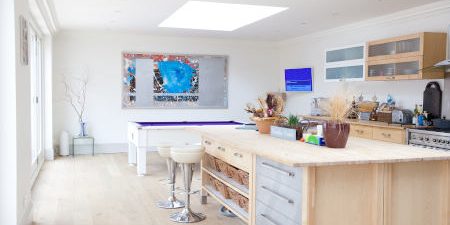Hindsight is a wonderful thing, isn’t it? It would be a particularly useful skill to have before undertaking a renovation project. Well, with the help of some local residents that have already been through the kitchen renovation mill, we’ve put together all their golden nuggets of knowledge and hindsight to create a comprehensive guide of things to consider before and during your kitchen renovation. So, whether your kitchen requires a complete redesign, an extension, or simply a few units replacing, this guide will give you the precious foresight you need.
Before you start your kitchen renovation…
Decide on your style. Whether, French country, cottage charm, country farmhouse or cutting-edge contemporary, decide on the look you want to achieve. Seek inspiration from magazines, kitchen showrooms, social media and Google. It is also a good idea to have a nosey around any friends and neighbours’ kitchens to check out what they have done.
Consider the time of year
Think about when you are going to start your project. Early spring when the clocks go forward is a great time to start, as the main disruption will take place in late spring/early summer when you’ll have more hours of daylight, you can utilise garden space (BBQ cooking), and cold dinners are no big deal. It is also generally, a nicer, more positive time to start a project.
Plan your budget
It is a good idea to add a 10-20% contingency to your budget and allow plenty of time. Be realistic with time frames – do not underestimate how long things take especially when factoring in manufacture lead times and trade availability. There will very likely be problems discovered which require lots of flexibility and patience on your part and they may add to the cost.
Pre-plan and minimise disruption
Try and pack your kitchen utensils up in order of how you use them and keep the everyday stuff to hand. Kitchen renovations can be a lengthy process, so you’ve got to get practical particularly if you have a young family to consider. Set up a temporary kitchen space elsewhere in the house, advisably near a bathroom where there is a tap to wash cutlery, plates and glasses. Keep the microwave handy too and try and batch cook meals that can be stored in containers and heated up in the microwave. After all, there are only so many takeaways you can eat (and afford!). Don’t underestimate the dust in the house. Cover everything! It might be a good idea to invest in plastic covers for door frames with a zip in the middle. They are brilliant at keeping dust in the kitchen and out of everywhere else.
Find the right people 
If you don’t ask, you don’t get! A good builder will offer his knowledge and experience up to you. Experienced builders will have seen it all, so they are often very helpful when it comes to ideas and thinking outside the box if things don’t go to plan or you have an awkward shaped corner to contend with. Your builder may even be able to order your kitchen for you at trade cost – it’s worth a try! Your kitchen supplier/designer will also be able to offer their expertise in solving problems, for example there may be a longer length wall cabinet available accommodate a high ceiling.
If you are extending, it may pay off to find an architect that has a good/proven relationship with your builder. It is important that they can work well together particularly if changes are made mid-way through the build.
No matter how good your builder and kitchen designers are, always measure everything yourself, then check and double check them. We are all human and make mistakes so the more people checking the better. It is also important to always check what builders/trade persons version of ‘finished’ means as it might not be what you expect.
Use builders that people you know recommend. Research your builders thoroughly and go and speak to them face to face, this will give you a good sense of how you will work together and if you think they understand your vision. Use certified installers, associated with a trade body (TrustATrader for example, is not a trade body it’s an advertising portal). Make sure to check your builder has the appropriate Public Liability insurance in place. If you are managing the project yourself and outsource anything to bona-fide sub-contractors (BFSC), ask to see their details. After all, anyone hiding this isn’t worth working with.
Get the approval you need
If you are extending, make sure you get your drawings approved by planning and building regulations (at your local council office) before you start. You will be surprised at the amount of people that start works thinking that permission will be a given just because other people in their road have done a similar thing. If planning is refused, you will have to take down anything you have built. Or you may be granted planning permission on the condition that a few necessary tweaks are made to your original plan, meaning you may have to completely start again.
Design, layout and planning…
It is important to have a thorough understanding of how you want the layout to be. It’s got to be practical and work for you and your families’ lifestyle. If you are aiming for an open plan kitchen/diner you may need to include a small workstation for a laptop for working at home days or maybe you’ve always dreamed of a breakfast bar for the children to sit at and do their homework while you prepare meals. Maybe you are an active family with a wealth of muddy boots and wellies to contend with, or maybe you are a couple who love cooking and need maximum worktop space. Your needs will determine your layout and design and whether you can fit it all into your current footprint, or whether you need a completely different set up.
Inbuilt recycling bins and microwave? Wine fridge? Do you need cupboard for a hoover, mop or brooms? Can you open your dishwasher doors without blocking any other cupboard doors (a nuisance particularly if it’s the cupboard where you want to put all your everyday crockery)? Do you need a towel rail for tea towels? Would it be beneficial to have your plates at arm-height, so you don’t need to reach too high or too low? If you are stripping back your walls to brick and using insulation and plasterboard, make sure you account for the thickness when working out kitchen cupboard measurements.
There are lots of things to consider when deciding on your layout and design, so don’t rush it.
Kitchen appliances 
If you are working to a strict budget, try and keep the plumbing where it is. Moving gas and water lines to accommodate the reconfiguration of sinks, ovens, stoves, or dishwashers is costly. If you do have the budget to rearrange appliances, make sure you keep your floor plan in mind. When it comes to layout, think about how you work in the kitchen. When unloading the dishwasher, you do not want to walk a mile to the cupboard to put things away or have the cooker/hob too far from the fridge.
If you are having a dishwasher installed into an island, remember to take into account the gap underneath the dishwasher door which may eat into the kick panel. It might be a great space saver to integrate your washing machine under your island, but will it work practically? For example, when you fit the island worktop, you may want it to overhang slightly to accommodate bar stools – will you still be able to get the fabric conditioner in the washing machine tray with the worktop overhanging above? It’s the simple things!
Oh, and self-cleaning ovens are also a god send apparently!
Lighting and plug sockets
A common find is that most people undertaking a renovation project do not realise that you must think about electrics at the planning stage of a project. Do you need extra lighting? Maybe you need a light in a larder, or you would like new spot lighting with dimmer switches and some pendant lights over your island? You need to consider your requirements at the start of the project as this will be vital when planning your layout – you don’t want lights shining down on top of the wall cupboards rather than shining onto your work surfaces or pendant lights hanging off centre of your breakfast bar or dining table.
The electrician will carry out a ‘first fix’ of electrics before your kitchen is fitted (to rewire), then come back to do a ‘second fix’ after installation (for fixtures). You do not want the electrician drilling holes in your newly plastered and painted ceiling or walls at this stage due to the knock-on effect of late alterations made to the layout. The same goes for plug sockets. Think about where your appliances will go so you can plan where you put them i.e. where will you make tea and put the microwave? If you are planning on having an island unit and want plug sockets on it – ones that pop up from the worktop seem to be a popular choice.
Top tips:
- USB plug sockets are super convenient for charging phones and iPads!
- Overhead lights are good for general illumination
- Spotlights are ideal for lighting up specific areas where you perform tasks
- Accent lighting is best used to highlight features in your kitchen such as under cabinets to highlight the work surface and splashback.
- Long-lasting LED light bulbs are a great investment, some brands claim to last up to 17 years!
Windows and floors 
When it comes to your floor, make sure it is level. It may sound like a given but a tiny amount of sloping (that you might not be able to see with the naked eye) could have a knock-on effect with everything else. Try to have your flooring chosen before you make any key decisions as your builder will need to know how ‘deep’ each tile is to accommodate everything that’s being fitted on it!
If you are having new windows fitted make sure to factor in manufacture lead times. At Wandsworth Sash Windows we have a 12-week lead time from the time of order, which often means customers having to think about finishes from the beginning of the project. Another top tip is to ensure wall cupboards don’t cover any newly fitted windows when cupboard doors open.
Worktops
Obviously, you will choose worktops that fit your preferred style and taste. However, practicality does play an important part…
- Quartz has fantastic stain resistant properties and comes in hundreds of different styles and colours.
- Granite has been used in the industry for many years, proving itself time and time again. It has a more natural look to it but, is just as hard wearing.
- Marble is good for a timeless, classic look. It’s a softer material than Granite or Quartz but still a great option. Marble can be treated to help prevent it from staining.
- Wooden worktops look great but can be challenging and a little unforgiving to maintain. Treating them with oil every six months or so will help keep them looking ship-shape for longer.
When your kitchen renovation work commences…
Stay calm and make sure you play an active role. Do not be tempted to go on holiday and avoid the chaos. It is important for you to be around to keep an eye on what is going on and make decisions quickly (if need be) so the project is not delayed.
Understand the running order of works

Knowing what will happen and when, will help you to check your builder is coordinating the right trades at the right times, factoring in lead times and keeping your project on track.
Get connected
There is nothing like a bit of moral support when you undertake a renovation project. Joining a DIY Facebook group will give you an opportunity to share advice, get ideas and vent!
So, there you have it. A ton of things to think about before embarking on your kitchen renovation journey. Remember, we are more than just a window company. As we have our own in-house team of skilled builders, we are able to manage all aspects of your projects. We have undertaken a wide range of extensions, property refurbishments, loft extensions and other large projects across London and the South East. From ground works to plumbing, electrics to tiling, landscaping to decorating, we can do it all. Please don’t hesitate to contact us if you need us to ease the burden of your project.

